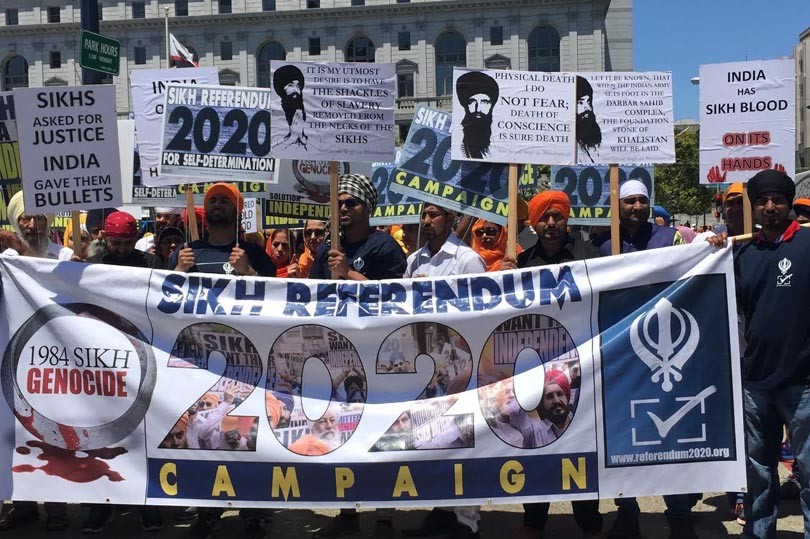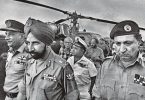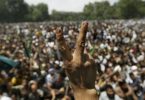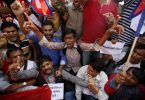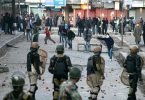The Subcontinent known as South Asia has huge diversity in religious groups. Taken together, South Asia as a region could be said to have the largest population of Muslims in the world. However, there are other religious groups in India such as the Christians as well as indigenous religions that originated in South Asia namely Hinduism, Jainism, Buddhism and Sikhism. Although indigenous religions are connected through the history of South Asia, they constitute a wide range of religious communities, and are not confined to the Indian subcontinent.
The adherents of Sikhism, known as Sikhs (Sanskrit for Disciples or students) whose male members are noticeable by their intricate and unique turbans, comprise about 2% of the Indian population. A sizeable population is also found in Pakistan. Globally, there are estimated to be 25.8 million Sikhs, of which an approximate 75% live in the Punjab, constituting 60% of the state’s population. Large communities of Sikhs live in the neighboring states such as Indian State of Haryana which is home to the second largest Sikh population in India with 1.1 million Sikhs as per 2001 census, and large communities of Sikhs can be found across India.
The initiated Sikhs also called Amritdhari refer themselves as a collective body known as the Khalsa. There is a lot of debate by scholars what this word means; some assert it means sovereign/free, while others contend it means Pure/Genuine. Some propose it means, “God’s own”. As it can be ascertained that with a global population Sikhism has become an international religion, however, it has faced and continues to face a set of problems like all major religions. The most prominent has been the quest for a Sikh state culminating into the demand of Khalistan in the current era.
The Start of the Khalsa
Sikhism is reported to be founded at around the time of Babur’s invasion of South Asia. Although the early Mughal emperors had peaceful relations with the Sikh Gurus, the Sikhs started facing religious persecution during the reign of Jahangir. Guru Arjan Dev, the fifth Guru, was arrested and executed by Emperor Jahangir in 1606.His successor Guru Hargobind formally started the militarization of the Sikhs. In 1675, Guru Tegh Bahadur, the ninth Guru of the Sikhs was executed by the Mughal emperor Aurangzeb, and in 1699, his son and the tenth Guru, Gobind Singh formed the Khalsa on 30th March. This new organization was to result in the creation of the Sikh Kingdom in 1799.
Formed by the legendary Ranjit Singh, this empire was to face its downfall at the end of the Second Anglo-Sikh war. It is contended, that the formation of the Khalsa is perhaps the greatest event in the history of Sikhism, as it consolidated the faith as a distinct and separate religion from other religions like Hinduism and not just another reform movement.
During the British Raj, the separate Sikh identity was to assert itself. The first major threat to be faced by the Khalsa was Hindu reform movements. The particular Arya Samaj movement was zealously working all over India and the Punjab to reduce non Hindus that also included Sikhs.
The Singh Sabha movement made a deep impact on Sikh psyche. The Sikh identity itself was under threat, unlike the military danger against the community by the Mughal Empire. This time the targets were the core beliefs of Khalsa and the Punjabi language.
This menace made Sikhs only reaffirm their values, and also become aware of their cultural shortcomings. The Singh Sabha movement made a deep impact on Sikh psyche. The Sikh identity itself was under threat, unlike the military danger against the community by the Mughal Empire. This time the targets were the core beliefs of Khalsa and the Punjabi language. Until then the Sikhs had been mainly deployed in the British Army, and a relatively few working in other fields like law and medicine, but these select few had to study in an environment which often led them to abandoning their religious practices. Therefore the Sikh effort, which could be mirrored in a similar endeavor by Sir Syed Ahmed Khan for the Muslims, was to create institutions which would strengthen Sikhism. Efforts were at last succeeded with the formation of Khalsa College Amritsar which opened on October 22, 1893.
The Sikhs and the Muslims had unsuccessfully claimed separate representation for their communities in the Morley-Minto Reforms of 1909. The proposal of a Muslim majority state in the form of Pakistan was opposed by many Sikhs. The term Khalistan was coined by the Sikh leader Dr. Vir Singh Bhatti in March 1940 and called for a Sikh country in the pamphlet called Khalistan, in reaction to the Muslim League’s Lahore Resolution. His proposal was founded on the conjecture that Pakistan, containing Sikh-inhabited territories, would be an Islamic theocratic state and by default inhospitable to Sikhism. The proposed Khalistan territory included portions of present-day Indian Punjab, Pakistani Punjab (including Lahore) & the Simla Hill States, and was to be established as a theocratic state led by the Maharaja of Patiala with the aid of a cabinet consisting of the representatives of other units.
In the 1940s, Mohandas Karamchand Gandhi stated that a resolution was adopted by the Congress to satisfy the Sikh community. Jawaharlal Nehru reiterated Gandhi’s assurance to the Sikhs at the All India Congress Committee meeting in Calcutta in 1946, and gave a guarantee to the Sikhs that they would be allowed to function as a semi-autonomous unit within the newly formed India. However, during a press conference on 10th July 1946 in Bombay, Nehru declared that the Congress may “change or modify” the federal arrangement agreed upon for independent India for “”the betterment towards a united India” This assertion caused massive outrage particularly among the Sikhs. On 21st November 1949, during the review of the draft of the Indian constitution, Hukam Singh – a Sikh representative, declared to the constituent Assembly that the “Sikhs could not agree to the constitution of India”
On 21st November 1949, during the review of the draft of the Indian constitution, Hukam Singh – a Sikh representative, declared to the constituent Assembly that the “Sikhs could not agree to the constitution of India
From Partition to Blue Star
After the formation Of Pakistan and India in 1947, there was massive deviation in the Sikh population on both sides of the border. The Sikh population increased in India mainly in the Indian Punjab. In 1947, a dismissed Sikh civil officer Kapur Singh asserted that Nehru had issued directives to treat the Sikhs as a “criminal tribe”. This claim was supported by Sikh factions, preeminently the Akali Dal – a political party.
The Akali Dal also initiated the “Punjabi Suba” movement in order to create a province for the Punjabi speaking population. On the other hand, the Akali Dal officially never insisted for an independent country for the Sikh nation, and at times, overtly opposed it. However, the issues raised during the Punjabi Suba movement would linger on to drive the support for a separate Sikh country.
The foremost was the matter of linguistics; the Punjabi language is an essential component of the Sikh faith. Punjabi was also the primary language of the Punjabi Hindus. However, the Indian government was wary of such a step as it would in effect create a Sikh majority state. Attempts were made to create rifts between the Punjabi Hindus and Sikhs by several Indian factions to weaken this demand. The case for creating a Punjabi Suba case was presented to the States Reorganization Commission, established in 1955. The States Reorganization Commission, not recognizing Punjabi as a language that was grammatically very distinct from Hindi, rejected the demand for a Punjabi state.
The Indian government was wary of such a step as it would in effect create a Sikh majority state. Attempts were made to create rifts between the Punjabi Hindus and Sikhs by several Indian factions to weaken this demand.
Finally, in September 1966, the Indira Gandhi-led Union Government accepted the demand, and provincial territorial reorganization took place as per the Punjab Reorganization Act. Until 1966, Punjab was a Hindu majority state (63.7%). But during the linguistic partition, the Hindu-majority districts were removed from the state. Chandigarh, the planned city built to replace Punjab’s pre-partition capital Lahore, was claimed by both Haryana and Punjab. Pending resolution of the dispute, it was declared as a separate Union Territory which would serve as the capital of both the states.
Another major factor was the dispute over the water shares from the three rivers of Punjab: Sutlej, Beas and Ravi. After the reorganization, the Haryana province was given a share in the Ravi River but Punjab was denied the Yamuna River. According to Sikh activists, Punjab remains the only state in India to have a shared capital and no control over its natural resources, water and electricity. The issue of state brutality on peaceful democratic processions like the invasion and despoiling of the Harminder Singh site in 1955 also had a huge impact on Sikh nationalism. But perhaps the most significant factor has been the clause in the Indian constitution that considers Sikhism as a part of Hinduism which is seen by many Sikhs as the greatest threat to their faith and identity.
According to Sikh activists, Punjab remains the only state in India to have a shared capital and no control over its natural resources, water and electricity.
The Akali Dal led a series of peaceful mass demonstrations to present its grievances to the central government. The demands of the Akali Dal were based on the Anandpur Sahib Resolution, which was adopted by the party in October 1973 to raise specific political, economic and social issues. The major motivation behind the resolution was the safeguarding of the Sikh identity by securing a state structure that was decentralized, with non-interference from the central government.
While the Akali Dal tried to remain in the national fiber of India, other Sikh leaders like Jagjit Singh Chauhan pursued the case for an independent Sikh state. Chauhan set up a network of pro Independence Sikh groups in Canada, UK and the USA, and called for the formation of Khalistan made up of Punjab, Himachal, Haryana and parts of Rajasthan.
During this time, an increasingly apprehensive Congress movement was perturbed both by the growing sway of the Akali Dal (its main rival in the Indian Punjab) as well as the rise of a Sikh religious leader Jarnail Singh Bhindranwale who called for more empowerment of the Sikhs. A list of attacks attributed to Bhindranwale by the government but never substantiated by proof, finally gave New Delhi the excuse to impose an emergency in October 1983.
In June 1984, an event would happen that would ignite the flame for Khalistan. The assault on Darbar Sahib, popularly known as the Golden Temple (the holiest of Sikh temples) by the Indian military forces using tanks and artillery – known as Operation Blue Star was conducted in order to evict a group of armed pro-Khalistan activists from the temple – a claim that remains controversial to this day with prominent politicians like Subramian Swamy asserting that this was a disinformation campaign to legitimize the attack. According to the Indian Army, 136 army personnel were killed and 249 injured. In all, 493 people in the complex were killed including Bhindranwale and 86 injured; the government report also mentions that 1600 people were unaccounted for, though it does not state what fraction were killed or injured. Unofficial figures go well into the thousands. Massive human right violations by Indian Army personnel took place like gunning down of prisoners and burning & looting of the Sikh Reference Library.
In June 1984, an event would happen that would ignite the flame for Khalistan. The assault on Darbar Sahib, popularly known as the Golden Temple (the holiest of Sikh temples) by the Indian military forces using tanks and artillery – known as Operation Blue Star was conducted in order to evict a group of armed pro-Khalistan activists from the temple
Retaliation by some Sikhs came in the way of the assassination of Indira Gandhi by her bodyguards, Satwant Singh and Beant Singh. This act triggered the anti Sikh riots of 1984, which has been reported to be a planned pogrom by the Congress against the Sikhs. This wholesale slaughter, which led to the deaths of many Sikhs including entire families, has been widely condemned by human rights activists, and has been designated as genocide by the California State Assembly.
The army occupation of Punjab which followed Operation Blue Star was highly detrimental to the Sikhs. Mass human rights violations like torture, extra judicial murders, rapes, illegal detentions, forced disappearances were inflicted upon the Sikh community by the Indian authorities to subdue resistance. Sikh groups resisted through an armed insurgency, which carried on for decades; the last militant incident happened with the death of Punjab Chief Minister Beant Singh. After that, while the militant activities of Khalistani groups decreased, there seemed to be a strengthening of financial and political support for Khalistan in the global Sikh diaspora. It was during this time that Indian authorizes started claiming that Khalistan had come to an end.
Retaliation by some Sikhs came in the way of the assassination of Indira Gandhi by her bodyguards, Satwant Singh and Beant Singh. This act triggered the anti Sikh riots of 1984, which has been reported to be a planned pogrom by the Congress against the Sikhs. This wholesale slaughter, which led to the deaths of many Sikhs including entire families, has been widely condemned by human rights activists, and has been designated as genocide by the California State Assembly.
Khalistan 2020: The New Wave
Apparently, the germination of the idea of Khalistan in the expatriate Sikh community is coming to full bloom. There is a strong sense of attachment among Sikhs to their culture and religion despite residing outside of India. There is an unrelenting demand for justice for the Sikh victims of Indian state oppression. In several aspects, the Sikh Diaspora is seen as the main driving force for the creation of Khalistan. Recent reports clearly indicate a rise in the pro-Khalistan sentiments among the Sikh Diaspora overseas, which can revive the independence movement.
Most of this sentiment is diverted to political non violent measures to attain Khalistan like lobbying and demonstrations. India complained to the USA about the role of pro-Khalistan elements in the launch of a Sikh Congressional Caucus inside the US itself. According to India’s intelligence agency Research and Analysis Wing, Sikh resurgence is imminent, given the increased activities of Pro Khalistan organizations globally, allegedly in countries such as Germany, UK, France, US, Pakistan and Malaysia. Protests have been held globally from Germany to San Francisco with as many as 10000 people attending these protests.
Recent reports clearly indicate a rise in the pro-Khalistan sentiments among the Sikh Diaspora overseas, which can revive the independence movement.
One of the main thrusts of the campaign is to hold an unofficial referendum by 2020 and to follow action in light of the results. The referendum asks Sikhs living across the world to build a consensus in favor of Khalistan, and sign a declaration for the formation of a sovereign and independent country in “India-occupied Punjab” on the basis that Sikhs are the indigenous people of Punjab, have a historical homeland, having a separate religion, and therefore have the right to self-determination. This is to be conducted under article 1 of the charter of the United Nations and will pave the way for UN intervention to set up a Sikh state.
Inside India there are signs of the revival of the Khalistan movement. Particularly Pro-Khalistan slogans were raised in Punjab on the 31st anniversary of Operation Blue Star, which led to the detention of 25 Sikh youth by the police. Pro-Khalistan slogans were also raised at a function hosting Punjab CM Parkash Singh Badal, as well as during a meeting between human rights activist Surat Singh Khalsa, who is on a death fast for political prisoners, and Simranjeet Singh Mann – the president of Shiromani Akali Dal, which advocates democratic procedure for the formation of Khalistan. Reports made to Indian authorities allege that the 2015 Gurdaspur attacks were part of a widening Khalistan revival. In Indian occupied Kashmir there has been confirmation of Sikh and Kashmir independence activists working together.
Conclusion
It can be concluded that like all major religions, the Sikhs are also embroiled in a struggle for nationhood that would end the threat of assimilation into Hinduism for them. Their struggle can be mirrored in the Pakistan movement which was initiated by Muslims who faced the same peril. While the formation of Khalistan may seem improbable now, future events and course of action are the factors, which will decide the faith of the struggle for a Sikh state.



